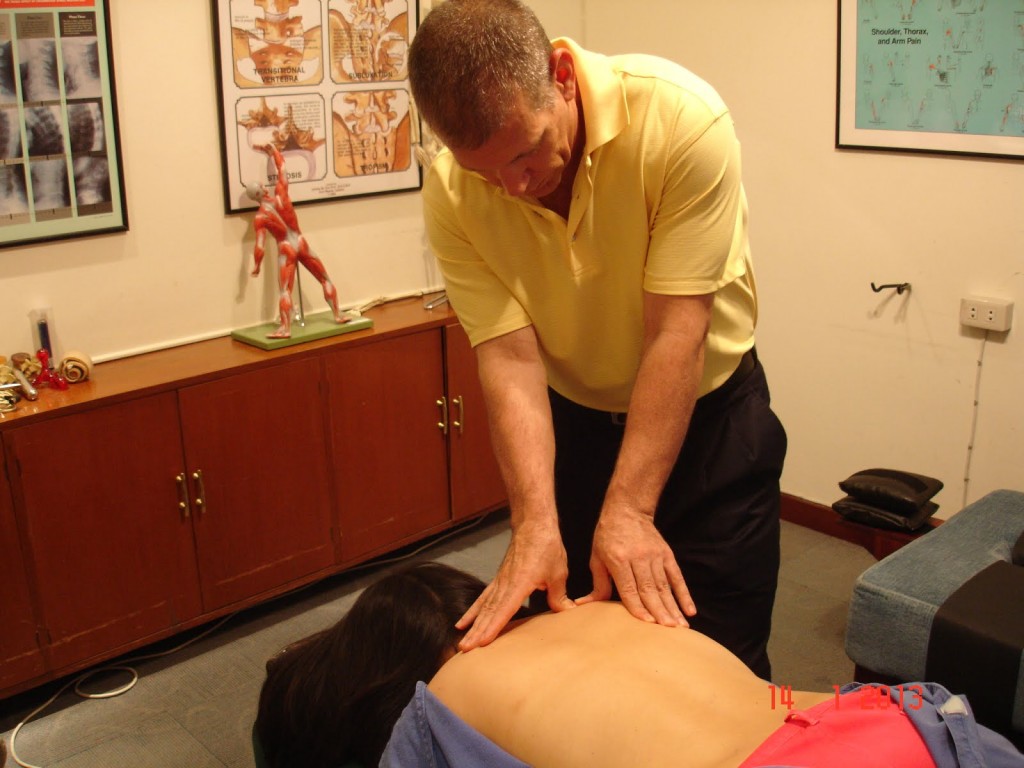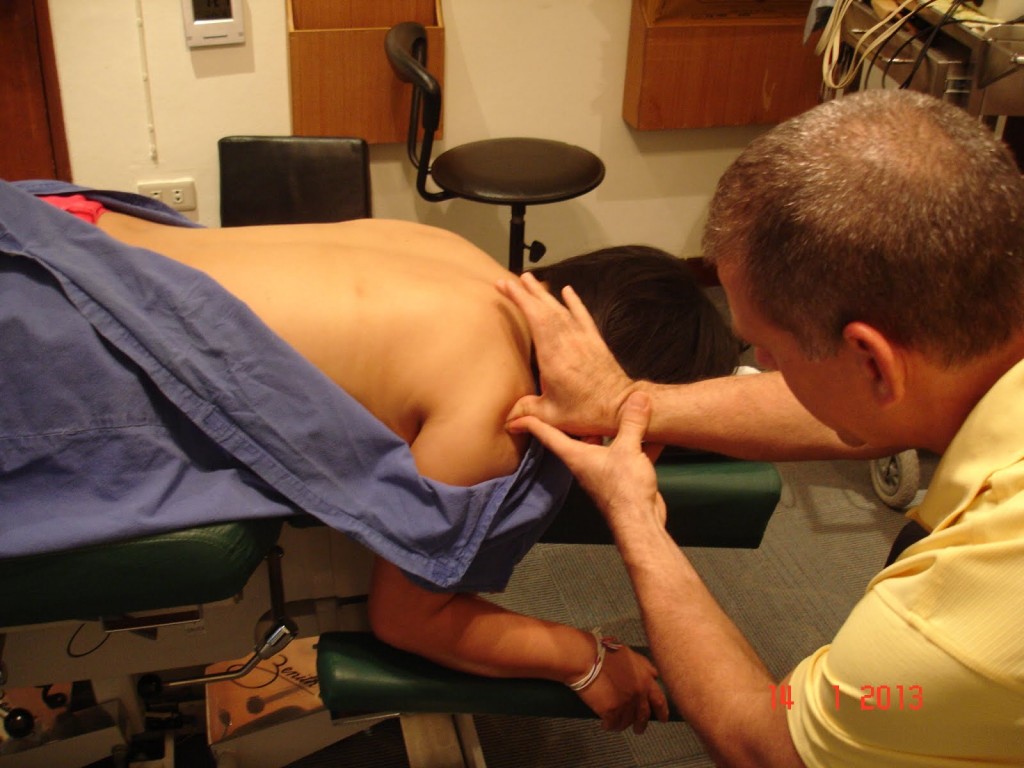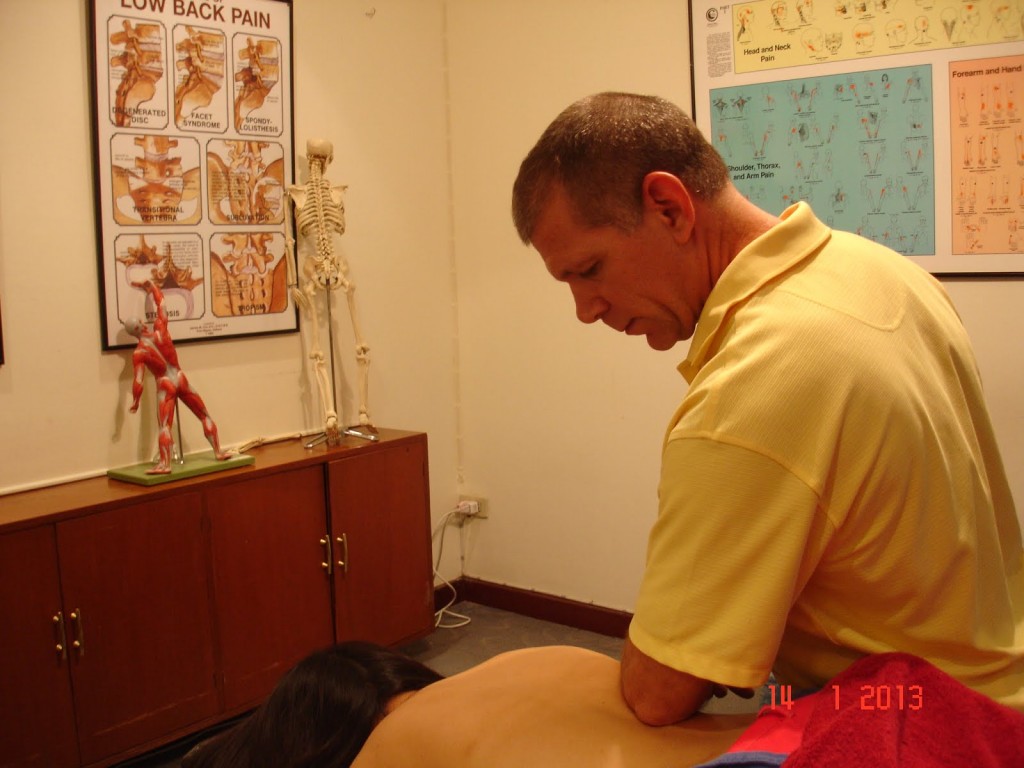Dr. Mark incorporates several types of therapeutic massage techniques into his management of the clinic?s patients. Below are some of the techniques he uses.
Nimmo Receptor Tonus Technique:

The purpose of this technique is to release Trigger Points in muscles. Trigger Points are hypersensitive nodules that form in muscles which cause the entire muscle to shorten and tighten. In addition to causing the entire muscle to shorten (tighten), Trigger Points also generate pain, both locally, at the site of the Trigger Point, and often to remote areas, far from the Trigger Point. The pain that radiates far from the actual site of the Trigger Point is called referred pain. For example, a Trigger Point at the top of the shoulder blade often radiates pain up to the neck and base of the skull. If you don?t release all the trigger points, both near and far from where a patient complains of pain, you will never fully resolve the patient?s pain syndrome.
This technique requires putting a small amount of lubricant on the skin over a muscle to be treated. A slow firm stripping massage is performed along the entire length of the muscle being treated. When a Trigger Point is found in a muscle, sustained pressure is held over the Trigger Point. The sustained pressure has the effect of releasing the Trigger Point, causing the entire muscle to relax and lengthen back to it?s normal length. This causes the pain associated with the Trigger Point to disappear.
Transverse Friction Massage (Cross Friction Massage, CFM)

Transverse Friction Massage is also known as Cross Friction Massage. It is a soft tissue technique concentrating mostly on the tendons and ligaments. The technique was developed by the late medical doctor Dr. James Cyriax, a giant in the field of orthopedic diagnosis and treatment.
INJURED TENDON OR LIGAMENT ? INFLAMMATION ? SCAR TISSUE FORMATION
When you damage a muscle, tendon, ligament or joint with an acute injury, there is a certain degree of tearing or stretching of the damaged structure. The tendons and ligaments can also be damaged without an injury, through chronic irritation from poor posture or activities such as computer work. To heal, your body needs to repair the damaged tissue by laying down collagen fibers, over the damaged tissue. These collagen fibers form what is known as scar tissue. We all have seen scar tissue form on our skin after suffering a cut. The same process occurs deep underneath the skin when you damage a muscle, joint, ligament, tendon or the fascia. Scar tissue can form around all these different structures. Scar tissue formation is absolutely necessary to repair the injured body part. If your body did not form scar tissue to strengthen and reinforce injured structures, your skeleton would eventually become so unstable from a lifetime of unrepaired injuries, you would eventually be unable to stand and walk.
The problem with scar tissue is that our bodies often create too much of it and of poor quality, meaning the scar tissue formed lacks enough flexibility to function similarly to the original tissue. Scar tissue is disorganized tissue, meaning the individuals fibers that make up the scar tissue are laid down in a random fashion, with the fibers running in every direction. This is in marked contrast with the fibers of tendons and ligaments which run in one direction, limiting only one direction of movement, while allowing normal movement to still take place. Transverse Friction Massage is one of the key techniques used to improve the flexibility of and alignment of the fibers of scar tissue formed over a tendon or ligament. When a patient suffers an injury to a tendon or ligament and fails to manually treat the scar tissue properly with Transverse Friction Massage , they are often left later with lost range of motion in the damaged body part. The shoulder, knee, ankle and wrist are common areas where tendon and ligament damage occur which benefit from Transverse Friction Massage.
Transverse Friction Therapy is performed by using 1 or 2 fingers over the thickened, scarred tendon or ligament and strumming perpendicular to the direction the fibers normally run. This has the effect of breaking down scar tissue that is not properly aligned with tendon or ligament while preserving the needed fibers of scar tissue that are aligned with the torn tendon or ligament, reinforcing it. To perform this type of massage effectively, you have to understand the direction the fibers of the injured tendon or ligament normally run in. Without in depth knowledge of the anatomy, the treatment can not be performed effectively. The strumming over the tendons is typically done for 10 to 15 minutes. If multiple tendons or ligaments are involved it can take even longer. It takes a great deal of strength and endurance in the hand muscles to perform this task over such a long period of time. For the practitioner performing Transverse Friction Massage, it is kind of like performing cardio and resistance training at the same time with only your hands. This is very difficult. It is for this reason that most manual therapist do not use this extremely beneficial technique. Dr. Mark has built up a great deal of hand strength and endurance with over 20 years of experience with this, and other soft tissue techniques.
Fascial Release

Soft tissue work targeting the fascia was first pioneered by Ida Rolf in the early 70s. Her technique was called ?Rolfing?. At the time she began promoting her work, her theories were not embraced by the mainstream musculoskeletal specialists in the fields of Chiropractic, Physical Therapy and Massage Therapy. Like so many visionaries before her, the true value of her insights was not recognized during her lifetime. Times change and recognition of the value of treating the fascia has now come of age.
The fascia is a layer tissue between the skin and the muscles. Fascia also surrounds each individual muscle and tendon. If you have ever cleaned chicken while preparing it to be cooked, you have seen fascia. Fascia is the layer of clear, slimy material seen underneath the skin. It kind of looks like wet saran wrap. Fascia allows the essential sliding and gliding of the muscles, tendons, nerves and skin in contact with one another. When the fascia thickens and hardens ( with scar tissue formation) due to chronic irritation, or an acute injury, it becomes dysfunctional, causing all the structures to stick together. It?s as if the skin, fascia, muscles and nerves have all been glued together, which causes painful musculoskeletal dysfunctions. Dr. Mark performs fascial release work to free up the fascia, allowing the various muscles, tendons and overlying skin to move independently of one another, leading to greatly improved function. Interestingly enough, it is now theorized that one of the ways acupuncture helps patients, is by actually breaking up adhesions in restricted fascia. We will sometimes incorporate acupuncture with the assistance of our Traditional Chinese Medicine Doctor for cases of extremely thickened fascia.
?I find that there are certain key components to each patient’s musculoskeletal problem I can only discover by performing soft tissue work.??Mark Leoni DC
Dr. Mark personally gets involved in most of the soft tissue work performed at the clinic. Dr. Mark finds that rolling up his sleeves and digging into the soft tissues gives him a much deeper understanding of the nature of each patient’s particular problem.
